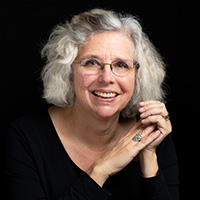
In this follow-up to last week’s episode on bowel resections and colostomies, Ruth has a chat with massage therapist Marie Ruxton, who shares her story of abdominal surgery and the remarkable experience she had with bodywork while she was recovering.
We could all wish to receive touch with such sensitivity and skill.
Resources: 
Pocket Pathology: abmp.com/abmp-pocket-pathology-app


This podcast sponsored by:
About Anatomy Trains:
Anatomy Trains is a global leader in online anatomy education and also provides in-classroom certification programs forstructuralintegration in the US, Canada, Australia, Europe, Japan, and China, as well as fresh-tissue cadaverdissectionlabs and weekend courses. The work of Anatomy Trains originated with founder Tom Myers, who mapped the human body into 13 myofascial meridians in his original book, currently in itsfourthedition and translated into 12 languages. The principles of Anatomy Trains are used by osteopaths,physicaltherapists,bodyworkers,massagetherapists,personaltrainers,yoga,Pilates,Gyrotonics,and other body-minded manual therapists and movement professionals. Anatomy Trains inspires these practitioners to work with holistic anatomy in treating system-wide patterns to provide improved client outcomes in terms of structure and function.
Website:anatomytrains.com
Email:info@anatomytrains.com
Facebook:facebook.com/AnatomyTrains
Instagram: instagram.com/anatomytrainsofficial
0:00:01.2 Ruth Werner: Hey, I Have a Client Who listeners, did you know I have a growing library of NCB approved one-hour online self-paced continuing education courses that you can do any time anywhere? Well, now you know, current classes include what's next, COVID-19 updates for massage therapists and a Massage Therapists Introduction to Pharmacology Part One, and brand new, a Massage Therapist's Introduction to Pharmacology Part Two. Classes are $20 each and they confer one hour of continuing education credit. Wanna know more? Visit my website at ruthwerner.com and check it out. Be sure to sign up for my mailing list so you'll never miss a new class.
[music]
0:00:55.9 RW: Hi, and welcome to I Have a Client Who... Pathology Conversations with Ruth Werner, the podcast where I will discuss your real life stories about clients with conditions that are perplexing or confusing. I'm Ruth Werner, author of A Massage Therapist's Guide to Pathology, and I have spent decades studying, writing about and teaching about where massage therapy intersects with diseases and conditions that might limit our client's health. We almost always have something good to offer even with our most challenged clients, but we need to figure out a way to do that safely, effectively and within our scope of practice, and sometimes, as we have all learned, that is harder than it looks.
0:01:43.1 RW: In a previous episode of I Have a Client Who, I posted something on Facebook about how interesting it is to write about colostomies and bowel resections, and it generated a lot of interest. In that process, I heard from a massage therapist named Marie Ruxton who practices in Pennsylvania, who has had an up-close and personal experience with this kind of procedure, and I have very happily invited her to share a little bit about what happened for her, how it affected her and her ability to both give and receive massage. So Marie, thank you so much for taking some time to help me out today.
0:02:19.0 Marie Ruxton: Thank you, Ruth.
0:02:22.5 RW: So tell me about your story about your bowel resection.
0:02:26.4 MR: Okay. In 2015, I started having episodes of diverticulitis, the left lower quadrant, which is a very typical area for that discomfort, and I had repeated episodes for three years, like every couple of months, and I went through the whole process with the antibiotics and the steroids and the restricted diet, etcetera. And I really thought that I could manage this myself for a very long time, and I tried homeopathic remedies and acupuncture, I had visceral release therapy, craniosacral therapy, myofascial. I tried...
0:03:15.0 RW: You did all the things.
0:03:17.4 MR: Everything. Including...
0:03:19.6 RW: And Marie, before you go any further, can I just get a quick question? How old were you when this began?
0:03:23.8 MR: 58, 59.
0:03:25.0 RW: Okay.
0:03:25.4 MR: And unbeknownst to me and this is interesting, all the women on my mother's side, all had bowel resections around my age.
0:03:33.3 RW: Oh, for heaven's sakes.
0:03:35.2 MR: Four sisters. Which I did not know until I had my issue, and my last remaining aunt said to me, "Do you know... " And of course, I did not. [chuckle] So I found that to be very interesting that it is a genetic predisposition. So what happened is, I did everything from fasting to eating congee, which is a rice concoction that you boil until there's nothing left but slush, and I ate that and soups for three years, and I really didn't stray from that too much thinking that it would heal the area, but it did not. And the last and final episode in 2018 was the last straw, and the surgeon just tapped me on the knee and said, "When you're ready to stop suffering, call me." [laughter]
0:04:33.5 RW: You have tried everything. You did your due diligence.
0:04:37.2 MR: Yes, I did. And so...
0:04:39.4 RW: And that's what why we really love our western medicine.
0:04:41.8 MR: Oh, absolutely. It was a miracle. Really. So I had the surgery and it was supposed to be done laparoscopically, but when he got in there, all my organs were encased in scar tissue, so he had to take them out and do a transabdominal cut and take everything out and basically dissect the scar tissue off, and he took 15 inches of my bowel and part of my rectum, and then he put everything back in, it took a long time for the surgery. It was supposed to only be like an hour and a half, I was in for over four hours, but I was very close to having a colostomy, but he saved my colon in that area. So my recovery was challenging because I asked him, "Did you put everything back where it belongs?" And he said, "No."
[chuckle]
0:05:32.1 RW: Oh, how interesting.
0:05:33.7 MR: It was interesting, I'm still receiving different types of therapy for that area, and my splenic flexure is in a different spot.
0:05:45.1 RW: Wow.
0:05:46.1 MR: It is actually three inches below where it normally should go, and it goes on a diagonal to my lower intestine and colon, so what I found through the surgical process was that having all the abdominal muscles cut in that area in the fascia, we use that, that's our core, that's what we use to motivate our body and to mobilize ourselves, so I found it really difficult to get myself moving. Consequently, I decided that I was going to rehab myself, so of course...
[laughter]
0:06:28.9 RW: 'Cause it worked out so well before.
0:06:30.9 MR: Absolutely. [laughter] But what happened is I started to develop some passive exercises and positional release therapy using my body to the point of resistance. For instance, I would bend my knee up and just let it drop and ratchet down to a point of resistance. I never went past that because, of course, the healing process, I didn't want to traumatize myself any further, but I did lots of different things, mostly supine, sometimes on my side, and it really enhanced the healing process, and I think my mobility. I was on my feet probably within two months, and I went back to work in... At five months, I really gave myself a lot of time to get my stamina back and my strength.
0:07:31.2 RW: You had an enormous surgery.
0:07:33.1 MR: Yes, I did, I did.
0:07:35.4 RW: It wasn't just a resection, it was clearing off of your internal organs.
0:07:40.1 MR: The scar tissue, actually, we determined with the surgeon was from a car accident from when I was in my 20s.
0:07:47.9 RW: Wow.
0:07:48.1 MR: Where there was a truck that came out, ran a stop sign and I missed it, but I hit a wall with my car, and so I had vaginal bleeding and rectal bleeding after that accident for three weeks, not knowing... Of course, they take their CAT scan and x-ray and they say, "Everything's working, it's bleeding, it's bruised. But everything's working."
0:08:14.6 RW: Oh my gosh. Yeah.
0:08:14.7 MR: So that's what he determined, he said this is from a major trauma, like a car accident, and it just... My brain went back there, and so all those years I've had that scar tissue, and after the surgery, my belly was really much flatter, it was fascinating, and so those three years of eating rice and liquid things and not really not being able to eat much at all, the belly was still there until after the surgery.
0:08:50.0 RW: So Marie, tell us a little bit about what it was like to receive massage after you had been through all of this. Do you receive massage on your abdomen, on your belly at all?
0:08:58.1 MR: Yeah. Oh, absolutely.
0:09:00.9 RW: Oh good.
0:09:01.0 MR: Absolutely.
0:09:00.8 RW: I love it.
0:09:01.0 MR: I actually found a wonderful male massage therapist, which I found interesting because I felt so safe with this young man, and he just had a knowing for touch and really feeling into the emotional component around the surgery for me, he was just so gentle and loving, the first time I saw him after the surgery was in the summer time I had the surgery in February, and June, I went to see this young man, and I just picked him. We were away on vacation, and I looked at all these different spas. I called, I spoke to some of the therapists there, I told them my concern that I was post-surgery, and they said, we have the perfect person for you. And he was. And I remember as he started to work in my abdomen, he was so loving in such an unconditional way that I just felt like that area returned to me, it was amazing, and I remember crying a little bit and not that kind of sobbing, but you know that kind of comfort where you just like you're home finally, and the tears are just coming out without really crying, that's where I was.
0:10:35.3 MR: And I remember he put his hand right on my belly, and he put his hand on my cheek and he said, "Is there anything I can do? What do you need?" And I said, I said, "You are doing everything that I need right now." I said, not, "No pun intended, but follow your gut," [chuckle] that's what I told him and he laughed, I laughed, and it was just really a one... It was a beautiful experience. I actually went back to him the next week, and then the next month. And I didn't live in the area where the Massage Center is, but every time I go to that area, I see him. Now, I haven't been there in two and a half years, but I have been thinking about going and receiving from him again, it's just... It was just, it was a holy experience, Ruth, it really was a holy experience, and I think because of that, it just rocketed my healing process and the emotional component of just feeling wounded in a way, and not having the energy or the chi, or the physical stamina to do the things that I wanted to do. And that made it all okay.
0:11:58.2 RW: Well, and I love what you said, I'll quote you incorrectly, but it was about that, "I felt like I was coming home to myself."
0:12:03.7 MR: Yes.
0:12:06.1 RW: So many people, therapists and people receiving massage are scared of the belly.
0:12:12.1 MR: Yes.
0:12:14.2 RW: And I've just... It's a bit of a soap box for me that it's so important that this be a beloved part of a beloved home, and it sounds like this guy was really, really tuned in, I'm so glad to hear about your experience. And I think that the title of this podcast will be 'follow your gut'.
[laughter]
0:12:35.2 MR: It's appropriate. [chuckle]
0:12:37.3 RW: Yeah.
0:12:39.6 MR: And I love making light of it, in a sense, with the humor, but at the same time, follow your gut means trust yourself and follow your gut, so that's most of my story.
0:12:53.7 RW: That's wonderful, and I think we'll draw it to a close there, that's just perfect. But I'm so, so grateful for you...
0:13:02.4 MR: Thanks for that.
0:13:02.5 RW: Sharing that with us, Marie, and best of luck, and when you have a different kind of 'I Have A Client Who' story, be sure and let me know, and it'll turn up another time. Thank you so much.
0:13:14.1 MR: I will, thank you very much. Take care.
0:13:15.2 RW: Hey everybody, thanks for listening to I Have A Client Who... Pathology Conversations With Ruth Werner. Remember, you can send me your 'I Have A Client Who' stories to ihaveaclientwho@abmp.com, that's ihaveaclientwho, all one word, all lowercase @abmp.com. I can't wait to see what you send me and I'll see you next time.
[music]